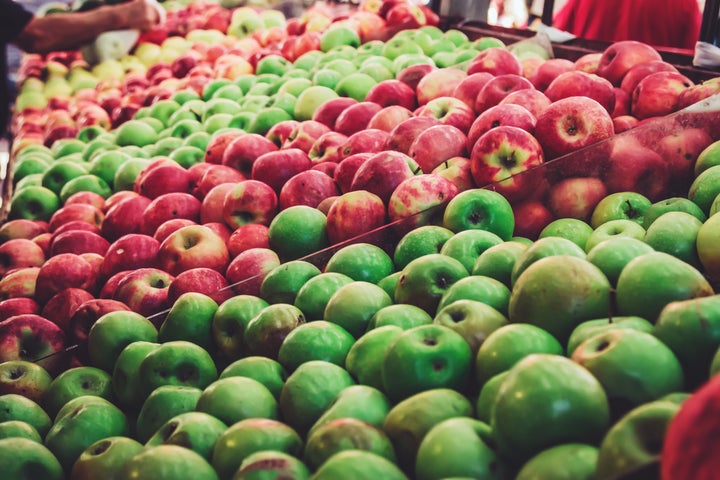Top bakers spill their best-kept secrets and their favorite varieties, from Northern Spy to Granny Smith.
TikTok may have boosted corn sales in grocery stores across the country over the past couple of months, but as summer melts into fall, it’s almost guaranteed that the produce section will be revamped showcasing a tried-and-true autumnal favorite: apples.
Though apples are available in most grocery stores year-round, they’re at their in-season prime in the fall in North America.
On the surface, baking an apple pie sounds simple. But choosing the wrong kind of apple can turn a potentially epic pie into an abysmal one, and trying to decide between the myriad apple varieties can leave you feeling stuck before you even get started. Granny Smith, Red Delicious, Cortland, Northern Spy …
Does it make a difference which ones you go for? Apple varieties do differ significantly in taste and texture, which will affect the outcome of your pie.
If you have no idea which ones to choose, consider this your pie-baking cheat sheet. Top bakers known for their apple pies reveal which varieties they like and why. Plus, they share baking tips that will take your dessert to a whole new level.
Don’t commit to just one variety of apple
Every expert pie baker we talked to shared the same pro tip: Use more than one type of apple.
“It’s not unusual for me to put six to eight varieties of apples in a pie — some for sweetness, some for tart notes, some that hold their shape and some that don’t,” said Kate McDermott, the author of ”Pie Camp.” “Each bite is a flavor adventure.”
A few of her favorites include Newtown Pippins (which are mildly sweet), Golden Russets (known for tasting a little spicy) and Bramley’s Seedlings (which taste sharp and acidic).
Ken Haedrich, creator of the blog “The Pie Academy,” prefers Northern Spy apples. “‘Spies are for pies,’ as the saying goes,” he said, adding that these apples are tart, tangy, juicy and firm.
Haedrich is also a fan of both Honeycrisp (which taste more sweet than tart) and Gala apples (which have a hint of vanilla). “An apple should have a little bite to it,” Haedrich said. “Juiciness and complex flavor are a real bonus.” One apple type that he feels is too one-dimensional for pie-making is Red Delicious.
While Red Delicious may be out, Granny Smiths are definitely in. ”The Essential Pie Book” author Saura Kline and “You Wanna Piece of Me?” author Jenell Parsons both say that good old Granny Smiths are their go-to pie-making favorites.
“In my bakery we use Granny Smith for the tartness it brings and it holds its shape nicely during the bake for those distinct apple layers, and Gala apples as they are sweeter, which balances the tartness and breaks down a bit adding a nice contrasting texture,” Parsons said.
No matter what apple types you decide to pick up, Kline said to make sure they aren’t already bruised because they’ll go mushy faster — not ideal for pie-making. “In addition, a wrinkly skin means the apple is old and would be better used to make apple butter than a pie,” she said.
OK, so you have your apples. But the expert pie bakers aren’t done dishing out their tips yet. It’s important to pay careful attention to your fruit throughout the pie-making process, from beginning to end.

Spice up and bake your apple pie to perfection
Cinnamon and nutmeg are the obvious go-tos for apple pie spices, but Kline likes to add cardamom, allspice, ginger and cloves to the mix, too.
Pro tip: Haedrich says to go light on the cinnamon, as it’s a strong spice and can overpower the apples, which is what you want to be most prominent.
Want to try something unexpected? Haedrich recommends adding a pear — a tip he learned from his dad. “Pears have a lovely floral personality that apples seldom do. They can elevate an apple pie like no other fruit, without being intrusive,” he said.
When you’re slicing your apples, deciding whether to peel them is a personal decision. Kline always peels hers because she doesn’t like the texture of unpeeled apples in pies, but McDermott leaves them on.
“Most skins become soft in the baking and their tannins add flavor to the pie,” McDermott said, adding that dark skins add a beautiful rosy blush to the filling when baked.
It’s also important to consider thickness when slicing your apples. Parsons recommends slicing them thinly (approximately an eighth of an inch), which she says allows them to stack best and create beautiful layers. She said they’ll bake more evenly this way, too.
Speaking of baking, one mistake the experts say most people make is not letting their pie bake long enough. Kline’s recommendation is to cook it at 350℉ for an hour and a half.
“You need to wait until you see thick, bubbly juice coming up around the crumb topping or through a steam vent you cut into the top pastry,” Haedrich said. “If you take your pie out too early, the apples will be under-baked and the juices will be runny because the thickener hasn’t had time to do its job.”
With all these tips, you’re well on your way to making a pretty stellar apple pie. But even if it doesn’t turn out exactly the way you want the first time, Haedrich said that pie-making is a journey, not a destination.
“You don’t get good at it overnight,” he said. “I often tell people that they can be 80% proficient with several months of regular weekend pie baking. The remaining 20% is all nuance and moving-target stuff, like the relative juiciness of your fruit. So just learn to enjoy the process and embrace your ugly pies. They’ll taste great.”
Credit: Source link